IDF 2009 - Intel Shows off 22nm & 32nm, Sandy Bridge Demoed
by Anand Lal Shimpi on September 22, 2009 12:00 AM EST- Posted in
- Trade Shows
This is a big IDF, it's my first without Pat Gelsinger at Intel. We're unlikely to hear much about Pat's departure here, but the rumor mill appears active with everything from him being kicked out due to Larrabee's initial issues (unlikely) to him not being selected to be the next in line for CEO succession at Intel (much more likely).

Sean Maloney, the heir to Otellini's throne at Intel - not Gelsinger
Regardless of what the motivations were, he will be sorely missed. Pat Gelsinger was the first person I met in this industry who truly blew me away with his knowledge. He has a rare combination of pure genius, passion and an incredible ability to convey even the most complicated concepts in a very easy to understand manner. He's been a tremendous influence on my own style of writing and knowledge, and for that I'll be forever grateful. Pat, you will be missed.
1B+ Transistors at 32nm, Working 22nm SRAM
Otellini gave us a status update on Moore's Law. 32nm is healthy and we'll see the first products based on Westmere later this year:
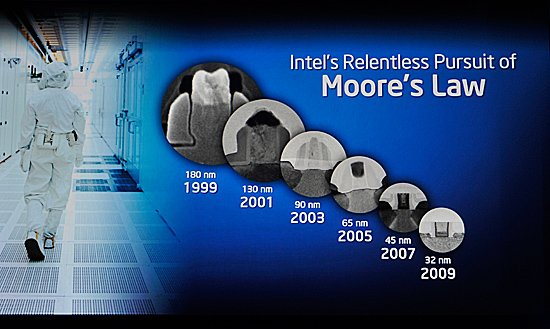
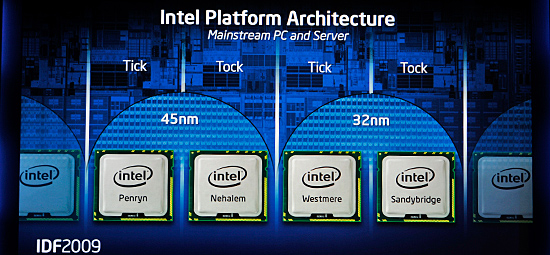
The move to 32nm will allow Intel to ship microprocessors with over 1 billion transistors into the consumer space. Sweet.
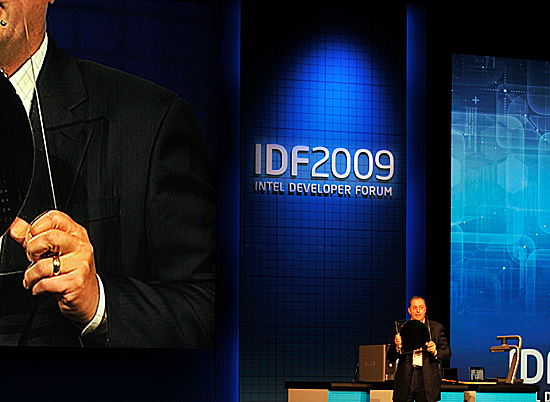
The first 22nm test wafer, fully functional
We also got the first look at Intel's 22nm SRAM test vehicle. The relevant details are as follows: 2.9 billion transistors per SRAM chip, each arey is 364Mb and production in CPUs in the second half of 2011.
Atom Gets Tick Tock, Sorta
Paul outlined the roadmap for the Atom processor and you'll notice that its progression looks a lot more like how Intel used to do things:
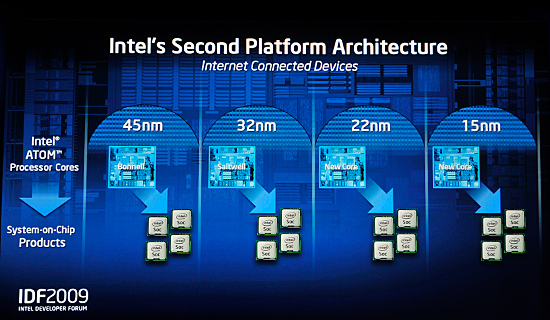
We'll get a brand new microarchitecture every "2 or so" years and transitions to smaller manufacturing processes on a regular basis.
Bonnell is the current 45nm core, Saltwell is the 32nm follow-up due out next year.

The move to smaller transistors ultimately has a different focus in the Atom space. While smaller manufacturing processes can be used to ramp clock speeds, in Atom the focus is going to be to reduce leakage current (and thus improve power efficiency/battery life). We'll see larger caches, more integration, but not necessarily higher clock speeds out of Atom in the future. Intel's goal here is to get Atom power consumption down to ARM levels.
Arrandale and Sandy Bridge Demos
An IDF keynote wouldn't be an IDF keynote without a demo of at least some unreleased CPU.
First up was Arrandale, the upcoming dual-core 32nm Westmere derivative. We got a demo of an Arrandale notebook running full disk encryption accelerated by the CPU's hardware AES instructions.
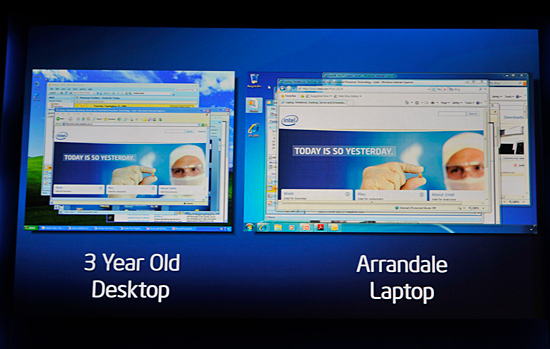
Sandy Bridge is the next major architecture shift due out in the second half of 2011. Built on 32nm, Sandy Bridge should be to Nehalem what Nehalem was to Conroe. It will also be the architecture that competes with AMD's long awaited Bulldozer cores. If all stays on track, 2011 should be very competitive in the high end CPU space.
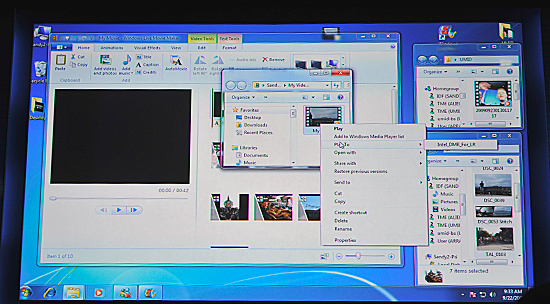
Sandy Bridge running Windows 7 and transcoding video already
The Intel Atom Developer Program
Intel announced the Atom Developer Program and its first three partners: ASUS, Acer and Dell.
The program is a way of encouraging development for Atom based platforms (and potentially testing the waters of moving people off of ARM and to x86 in the ultra mobile space).

ASUS CEO, Jonney Shih
ASUS' CEO Jonney Shih was present via pre-recorded video to pledge ASUS' support for the Atom Developer Program. Mr. Shih also announced ASUS' Eee App Store, for users to develop applications for Atom based Eee devices from ASUS.
Moblin 2.1 Demo
Moblin is a mobile optimized Linux distribution designed for notebooks, but next year we'll start seeing it on MIDs (again, one step away from getting Atom ready for the smartphone).
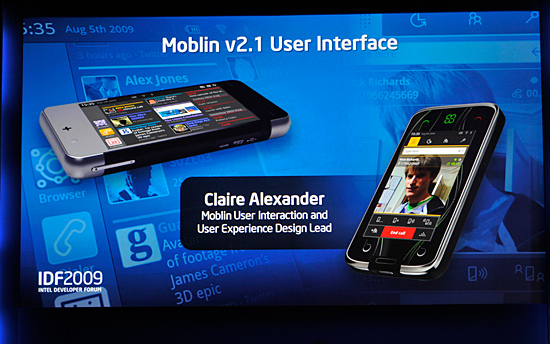
Intel did a quick demo of the Moblin 2.1 UI on a MID. The UI isn't particularly amazing by smartphone standards, but it's getting there. One more generation and I think we might have something that could really be used in a smartphone.
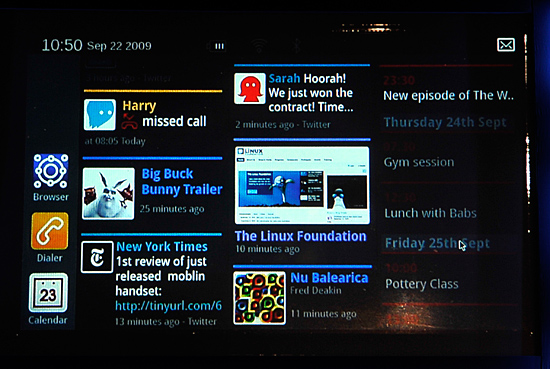
Intel's goal here is to bring the netbook usage experience to the MID. Honestly, that's been the biggest limitation to MID adoption in my mind: scaling down a desktop UI to a 5" screen just doesn't work well. A brand new touch UI is necessary for MIDs to be useful and Moblin delivers just that.


You can give Moblin a try on your netbook here.










34 Comments
View All Comments
ekoostik - Wednesday, September 23, 2009 - link
Between your "Intel will never be the same with out Pat" comment and Anand's stirring remarks (eulogy?), it sounds like the man died! Ok, in all seriousness now, I understand paying respect where it is due to the man and his work. Maybe now that he's an outsider, so to speak, you could convince him to do guest articles from time to time.yeeeeman - Thursday, January 14, 2021 - link
Well, Intel never was the same without Pat and Pat is actually now the CEO :))gianly1985 - Tuesday, September 22, 2009 - link
"Otellini gave us a status update on Moore's Law. 32nm is healthy and we'll see the first products based on Westmere later this year."Is there any hope to see Westmere CPUs in November? I'm thinking about the upcoming (?) iMac hardware refresh.
IntelUser2000 - Tuesday, September 22, 2009 - link
November seems a little too early, I don't think they'll release it earlier just for Apple either.eilersr - Tuesday, September 22, 2009 - link
So...still no Larrabee coverage?Hmmm...
Apahutec - Tuesday, September 22, 2009 - link
nothing very exciting so far... only more of the same, while Larrabee is potentially something new (in terms of possible applications)Eeqmcsq - Tuesday, September 22, 2009 - link
Nice coverage. Intel is simply on fire in all tech areas.fri2219 - Tuesday, September 22, 2009 - link
On fire? Are you kidding me? Companies that are "on fire" don't suddenly excuse a third of their top management in a month.They'll never recover their Ronler Acres costs, they were completely unprepared to scale up Atom production, they've burned half their production and R&D capital reserves in a year....
TA152H - Tuesday, September 22, 2009 - link
Not really. The Atom has a horrible chipset out now, and has been out too long for this to be acceptable. The Lynnfield is a solution looking for a problem. It's not the real deal, and it's too expensive to sell low cost, and more than this, they don't have an IGP for it.They put out two half-baked products, that could be successful were they hitting all on cylinders, but probably will wait until they combine them with another chipset, or combine it with internal video before they really reach their potential in their markets.
Intel is really weird. They have a lot of good, but they seem to skip the important details to fill out their products. It's kind of the opposite of before.
I think AMD's announcement is much more important. The i860 and i870 are essentially nothings - they don't really address a market very differently than before. The i5 750 is an important product, as it moves a lot of processing power into an important cost segment, but then, there's no IGP for it. If they had an IGP for the Lynnfield, I think it could really take off, especially with the i5 750. Instead, the sales are disappointing. I said this before they admitted it, so why couldn't they see this also? Anyone could, if I could.
AMD should do very nicely with the new $99 quad core Athlon. The i5 750 is better, no question, but does it come with IGP? Nope. Does it cost as little? Nope. Is it easy to communicate to average people that this processor is really better? Nope.
Score one for AMD, price and platform should win over a superior processor. Although, the Intel name carries a lot of weight.
Until they have an IGP, Intel needs to lower their prices of the Lynnfield if they want to sell them in numbers. Until then, AMD and Core 2 should still take the Lion's share. Well, until they get an IGP. Then the low end Lynnfields should be really attractive.
wariz2000 - Wednesday, September 23, 2009 - link
This guy looks like he is secretly paid by AMD. For non gaming tasks G45 is more than good. But of course you won't want this to come out, would you? Then again to some ppl gaming is everything.See this review of G45 on MissingRemote.com a HTPC focused website:
http://www.missingremote.com/index.php?option=com_...">http://www.missingremote.com/index.php?...amp;task...
Article discusses G45’s rough start but finally gives a big thumbs up to G45 on video quality, with picture quality rated better than an ATI discrete card
“Picture quality was tested against an ATI 4650 (Catalyst 9.4) by watching a ten minute sequence from a BD disc, switching inputs on the AVR to watch the same sequence on the other card using the same software player, then repeating with another sequence from another disc. The quality was noticeably better on the G45, especially in darker scenes where some of the finer detail was lost on the ATI card. “
“Best Blu-ray (and HD DVD) playback I've seen”